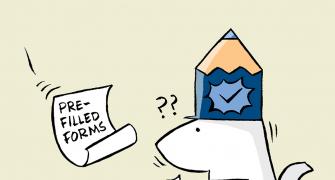Form 16 contains details of salary income, deductions, and exemptions.

Form 16 plays a crucial role in accurate filing of income-tax returns (ITR) by taxpayers.
This form, issued by employers, shows the tax deducted at source (TDS).
"According to Rule 31 of the Income-Tax (I-T) Rules, employers must annually issue Form 16 to employees by June 15 of the following financial year. For example, Form 16 for the financial year 2023-2024 should be given by June 15, 2024," says Suresh Surana, founder, RSM India.
Form 16 contains details of salary income, deductions, and exemptions.
"Section 203 of the I-T Act, 1961, mandates every employer acting as a tax deductor to provide employees or deductees with a certificate stating the deducted tax amount, rate, payment date, salary computation, etc," says Surana.
Form 16 consists of two parts. Part A includes essential details such as taxpayer and employer information, service period, and the amount of tax deducted.
Part B provides details of the tax computation carried out by the employer.
Check details of Form 16
Employees must first verify basic details, such as their Permanent Account Number (PAN) and the employer's PAN and TAN (Tax Deduction and Collection Account Number).
Form 16 and Form 26AS should contain identical TDS details.
"Verify TDS deductions in Form 16 against entries in Form 26AS to ensure accuracy," says Shyam Gopal, partner, Traya Law Partners LLP.
Form 26AS may not show the tax deducted by the employer if the PAN is incorrect, affecting tax credit claims by the employee.
Ensure that all the taxes deducted are credited.
"Verify salary details, like salary components (basic, allowances, and benefits). Make sure deductions under Section 80C, 80D, etc. match investment proofs," says Amit Bansal, partner, direct tax, Singhania & Co.
"Check for relief under Section 89 and confirm accurate reflection of relief for salary arrears, if applicable," adds Bansal.
Sometimes, tax-saving deductions and exemptions claimed are not correctly reflected in Form 16.
"In case of any discrepancy in the details, the employee may approach the employer to revise their TDS returns and provide them with a revised Form 16 after rectifying the error," says Surana.
If you have multiple Form 16s
When an employee changes jobs in a year and has multiple Form 16s, s/he should share her/him previous salary details with the new employer to ensure accurate tax calculation.
"If not done, the employee will have to pay taxes while filing the ITR," says Alay Razvi, partner, Accord Juris.
Tax liability arises at the time of ITR filing because each employer considers exemptions and deductions in their calculations, and they are claimed twice in a year.
"While calculating the taxes for ITR filing, the details of both the Form 16s need to be clubbed. Deductions and exemptions should then be considered to arrive at the tax liability," says Razvi. Incomes, too, need to be combined.
"Total the income from both employers to determine your annual income," says Bansal.
Exemptions such as house rent allowance (HRA), leave travel allowance (LTA), and standard deductions should not be duplicated, he adds.
Deductions must be limited to the threshold for a single taxpayer.
"Though standard deduction may be listed separately in both forms, remember that it can only be claimed once," says Bansal.
Preserve documents
Keep both Form 16s and other relevant documents handy in case you face queries from the taxman.
If no tax is deducted, the employer is not obligated to issue Form 16, but employees can ask for Form 16 Part B for smoother tax filing.
- MONEY TIPS
Feature Presentation: Ashish Narsale/Rediff.com










